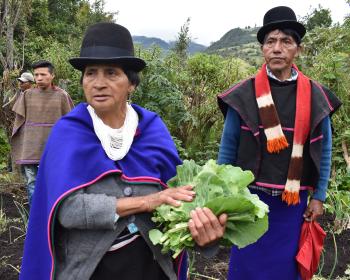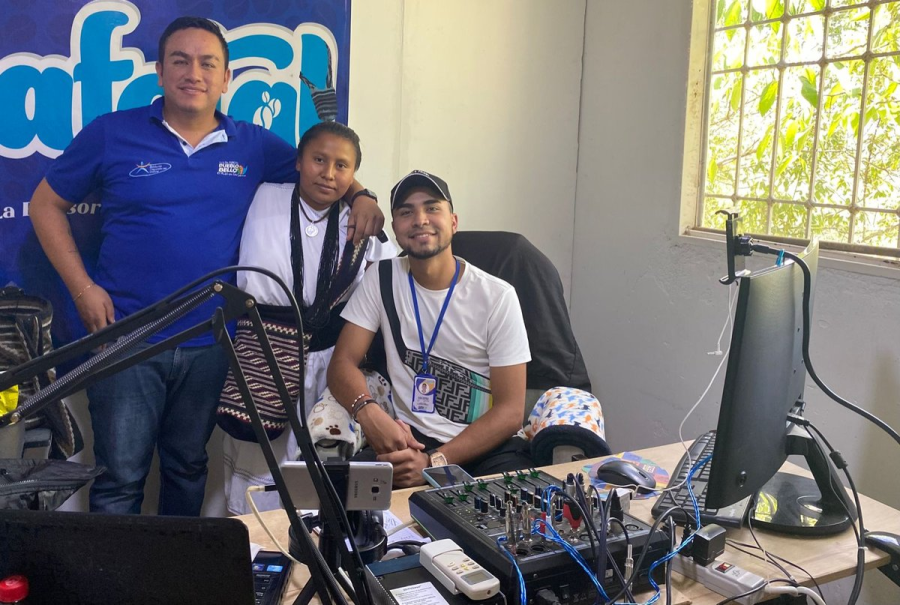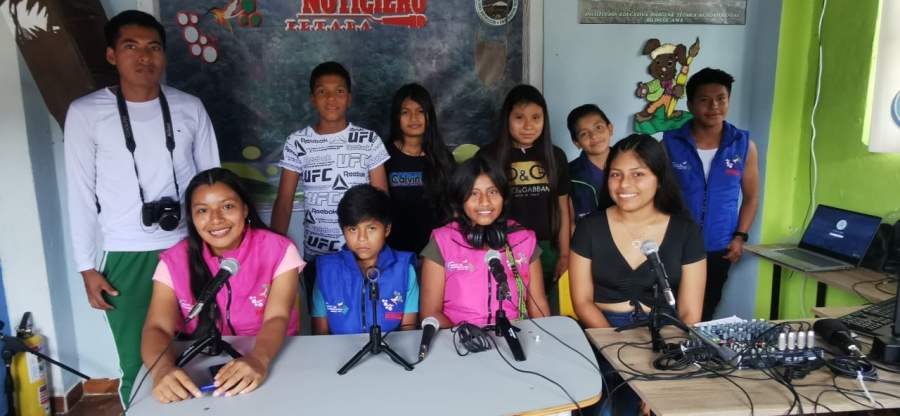In early April 1988, colonists from the town of Calamar believed their fantasies of seeing "primitive, wild" Indians had materialized when 41 Nukak Indians arrived at the doorstep of a rural school.
Residents from the area surrounding Calamar, in Colombia's southeastern jungle Guaviare Province, were used to the Tukano, Desano, Cubeo and Piratapuyo Indians of the region whose lifestyles, dress habits and systems of economic subsistence resemble those of the white colonists. Most of the indigenous populations inhabiting what is today Guaviare are themselves colonists, strongly influenced by the white culture. They migrated north, primarily from the Vaupés Province, finding a partial solution to their socio-economic strife by working for rubber companies, building roads and, later, cultivating coca.
The ancient indigenous groups that populated the area in pre-Colombian times were wrenched from their lands first by slave traders during the seventeenth- and eighteenth-century rule by the Spanish and Portuguese. Those that resisted - the Korea, Urubu-tapuyos and Mitus, for example - were later exterminated when the first wave of large-scale rubber exploiters arrived in the late nineteenth century.
Therefore, when the Nukak showed up in Calamar, fleeing a still undefined peril in the Papunaua and Inirida river regions, peasants and townspeople were more than surprised. Local knowledge about groups like the Nukak, or the Makú, was until then limited to stories of cannibals and naked savages.
The Nukak survived the violent history of the Guaviare region due to their adaptation to the inaccessible depths of the tropical rain forest in the Papunaua and Inirida basin, an area 90-200 km from Calamar. A second community survived in the marshy jungle between the Inirida's northern shore and the Guaviare River. Both groups of Makú were identified by Reichel-Dolmatoff in 1967.
Twentieth-century violence forced the Nukak to flee after several of their men were killed. Concurrent with the Nukak's arrival in Calamar, colonists north of the Inirida reported that a group of Indians, apparently from the second community, had appeared unexpectedly near Cano Jabón on the Guaviare River, a considerable distance from their hunting-and-gathering lands.
Reasons Behind the Exodus
Although colonists and Indians in Calamar possessed knowledge of some 20 different indigenous languages, no one understood the Nukak. Only when two US missionaries from the New Tribes Mission arrived was communication possible. One, Miguel Conduff, said he had been working with a similar group since 1968. He understood the language well enough to communicate effectively, but the results of 20 years of study of these communities are absent from Colombian historical, linguistic and anthropological records.
According to Conduff, the Nukak said they had fled from their traditional hunting-and-gathering lands when white colonists unleashed a "castigating spirit" against them to avenge the "robbery" by a group of Indians years earlier of a "white child." At least two Nukak still had shotgun bullets embedded in their shoulders. Conduff inferred that the colonists had attacked the group at gunpoint. The Indians believed that the angry colonists then sent another spirit - a cold virus - after them.
This version is confusing, making the events that forced the Nukak to flee their jungle habitat and head west a mystery. Conduff told local authorities in Calamar that the simultaneous flight of a second group further north was also a result of the conflict over the stolen white child. But more than 90 km of thick, marshy jungle spread between the estimated points of departure of the two dislocated populations, making it nearly impossible for a single group of colonists to have simultaneously uprooted both communities.
Residents from Calamar who accompanied the Nukak said the Indians were terrified of helicopters and anyone bearing arms. In January, the Colombian army upstepped counterinsurgency operations in Guaviare against Colombia's oldest and largest guerrilla organization, the Revolutionary Armed Forces of Colombia (FARC). Meanwhile, colonists from Papunaua said a right-wing death squad has been terrorizing inhabitants of their region since 1986. In early May, the Guaviare Union of Small-Scale Agriculturists registered complaints in the Colombian attorney general's office claiming that a "killer airplane" - an unmarked DC-3 - was making frequent flights over whole jungle areas "shooting at huts sighted in the jungle and canoes embarking on the rivers." Finally, an official from the Colombian Office of Indigenous Affairs pointed out that antinarcotic teams have also increased coca eradication activities near Lake Garza and Morichal Viejo, settlements bordering the Nukak hunting-and-gathering territories.
The Colombian government, meanwhile, has not conducted a thorough investigation to determine the reasons behind the Nukak exodus.
The Indians headed in a direct line west because one of their leaders, a woman, dreamed that other members of their Kakwa family lived in the direction "where the sun sets." Mutual fascination between the Nukak and colonists from Calamar, however, temporarily postponed the Indians' search for other Kakwa. Calamar, a jungle hamlet that has been both a prosperous village as a result of rubber and coca bonanzas and later a ghost town due to the declines of both "booms," opened its arms to the Nukak with surprising - although paternalistic - concern.
Such an attitude would probably not have existed in other parts of the country. The colonists of Calamar, however, share a concept of coexistence similar to that of many indigenous communities. Their communal psyche and fraternal social structure spring from their own disrupted history. Guaviare in the 1950s became a refuge for thousands of Colombian peasants who fled their lands during a bloody civil war known as "la violencia" (1948-1960). Fleeing both violence and poverty, more migrated in the mid-1960s and late 1970s. Uprooted from Tolima, Huila, Cundinamarca and Boyacá provinces, the peasants arrived in a vast, unfamiliar jungle. In order to survive, these displaced communities learned to work with the rhythms of the jungle rather than to fear it.
It was, fortunately, this community that received the Nukak. (In other areas of the jungle and plains, colonists in the recent past have considered killing Indians a virtue.) Calamar residents gave the Indians food, hammocks, aluminum pots and even razor blades - thinking that the fish teeth the Nukak used to trim their precise-line haircuts might not be available in the town. They took the Nukak for jeep rides, gave them clothing and welcomed some in the village discotheque. The local sports committee and the unions set up vigilance brigades to assure that the overly curious would not disrupt the Indian camp, located several blocks from the town.
The central government's response to the Nukak was bankrupt by comparison. A formal commission from the Interior Ministry's Office for Indigenous Affairs visited the group in late May and early June. A physician treated the majority of the Indians for parasites (with no possibility for continued treatment), bribing them with eggs. He also attempted to give the Nukak antibiotics-observing that many had severe coughs and colds - but they refused. The commission concluded that if the Nukak decided to return to their homeland, the government would create a reserve for them. No further action has been taken in this respect, however, nor has a comprehensive study of the group and the conditions it needs for cultural survival been attempted.
Moreover, the commission depended solely on the US missionary for translation, despite doubt expressed even by government officials as to the veracity of his interpretations. Finally, local Calamar officials, convinced that a more permanent solution was necessary, began to coordinate a prolonged study of the group by Colombian linguist and anthropologist Leonardo Reina, investigator for the official Colombian Institute of Anthropology (ICAN) and an expert in the language of the Yujubde-Makú from Caño Sucre in the Apaporis.
Officials from the Office for Indigenous Affairs were aware of this linguist's knowledge of the Makú language and his willingness to offer assistance, but they initially excluded him from the government commission. The office said it lacked resources to fund the prolonged study, yet financed what local authorities referred to as "Nukak tours," sending anthropologists from the central office and even a social worker whose professional skills contributed little to solving the Nukak's situation.
Origins of the Makú and Nukak
When the Nukak explained that the focus of their journey was to find other Kakwa, some of the questions as to their origin were answered. Language comparisons later revealed that the Nukak are closely related to several groups of Makú residing in the Vaupés Province in the Querary river basin, who also call themselves Kakwa. The Kakwa are included under the name Makú, a socio-economic appellative derived from an Arawak term meaning "slave."
The Makú maintained a hunter-gatherer, occasionally fishing culture of the jungle. After three or four generations, when the invasion of the rubber companies forced other indigenous groups into their territories, some Makú began to adopt small-scale agricultural techniques. The integral jungle cultures of those Makú communities hidden in the deep tropical rain forest of the upper Inirida, however, remained intact.
Myths from the Bará Makú and a parallel analysis of climatic changes in the region allow us to construct hypotheses of the migration and dispersion patterns of the Makú. Studies document a severe drought in the Colombian eastern Andes and plains 5,000-6,000 years ago, forcing the region's inhabitants, originally adapted to humid rain forests, to migrate to a remaining few humid oasis or jungle refuges. One of these was the Imerí-Vaupés refuge in the Amazon region surrounding the Negro and Isana rivers. Extensive rains in the Imerí-Vaupés, however, eventually deteriorated the soils, and today the region lacks dense jungle vegetation.
The soil deterioration could have forced the Makú to migrate back north, after the drought ceded and the jungle was replenished. The hypothesis of the migration patterns is also supported by linguistic comparisons of the Puinave-Makú languages.
Several stages of cultural adaptation, intrusion or transformation exist among the various groups of Makú. For example, the Makú of the Vaupés are considered "inferior castes" by other indigenous groups. The Tukano use them as servants, the Cubeo and Piratapuyo call them "messengers" and Koch-Gruenberg tells of one Tukano community in the Tiquié River that had 100 Makú slaves. Some white inhabitants of the region, too, employ them as poorly paid day laborers. Other Makú in Vaupés, near Mikú, have become bilingual teachers in Catholic schools. The Bará, in comparison, have maintained their hunter-gatherer culture, and the Makú in the Negro and Japurá river regions resisted the invasion of rubber mongers because they were considered fierce and dangerous.
The Nukak - pacifist, good natured, curious and sensitive, according to the Calamar colonists - revealed an intimate relationship with the jungle. As they traveled west, heading into a savanna climate, several of the five different plants needed to make their exclusive and treasured curare poison for hunting became scarce, forcing them to employ a different technique: the Nukak wadded a ball of rubber gum into their blowpipes and spat it at flying game. The sticky substance stuck to the birds' wings, impeding their flight and making them easy to catch by hand.
The Nukak relish a variety of fruits and seeds that only grow in tall, prickle- and spike-covered trees. Instead of felling the trees, they spiral-wrap their arms and legs in reeds - Ace-bandage style - to protect their skin from thorns as they scurry up the trees to pluck the fruit from the branches.
To extract honey without getting stung, the Nukak first call a jungle bird to scare the bees away from the hive. They also know which plants can be burned or spread on the body to ward off flies and mosquitoes.
Requirements for Resettlement and Relocation
The disproportion between the sexes in the adult Nukak - six men, 17 women and 18 male and female children - makes it essential for the group to link up with other Kakwa to maintain both their production and reproduction systems. Their marriage patterns are prescriptive, based on cross-cousin, unions (daughter marries the son of her father's sister, son marries the daughter of his mother's brother). The preferred union is a cross-cousin kindred marriage, but adjustments are commonly made to complete the system. Residence is patrilocal.
Several immediate family home units form a local walking group of around 80 members. Three walking groups constitute a swoa (the Bará term), or a regional dialect group that is relatively endogamous. If pairing cannot be completed within a swoa, marriages can be arranged with kindred from clans of another regional group. The wife then joins the husband's walking group.
The Nukak seem to want to establish a relationship with another Kakwa swoa, since it would supply them with male hunters on a short-term basis and assure reproduction in the long term. Older Nukak women were not pleased when the female adolescents began to eye colonists as possible mates, probably because the elders understand that such unions would not contribute to the maintenance of marriage patterns in future generations.
The need to resolve the productive-reproductive and matrimonial problems of the group must be the foremost concern in any project aimed at relocating or resettling the Nukak. The Office of Indigenous Affairs has not addressed this issue, primarily because it maintains the concept that the Nukak are a group apart from other indigenous communities in the region. One anthropologist from the office even insisted initially that the Nukak were not related to the Makú family.
The most logical answer is to help create a pact between the Nukak and other Kakwa. Once the communities establish initial communication, the problem of where the expanded community should settle can be broached. Several possibilities exist:
1. Create a reservation in the jungle surrounding Calamar. Local authorities have already considered the proposal and were capable of carrying out an agrarian reform with no government assistance in 1983. This alternative presents certain risks for the welfare of the Nukak community, however. The region surrounding Calamar is engulfed in violence and the bonanza nature of the regional economy has in the past contributed to the assimilation of the indigenous groups into white culture.
2. Create a reservation in the traditional hunting-and-gathering territory of the Nukak and reinstallate the group and other Kakwa there. Because Colombia has ratified Agreement 107 of the International Labor Organization's legislation, the Nukak have legal rights to the territory. This would also allow the community to defend its right to mineral resources that are believed to exist in the area. Before this step could be taken, however, the factors of violence which caused the Nukak's original displacement would have to be identified and eradicated.
3. Relocate the Nukak in the Wacará area of the Querary once the Kakwa in the area accept the group. Many Kakwa of the Wacará, however, have adopted roles as servants and day laborers. Moreover, the area is also a war zone.
4. Facilitate a pact between the Nukak and the Bará in the Macú-Paraná river basin. This is also an area of conflict and some Bará are subjected to positions as servants. The cultural identity of the Bará community, however, is more intact than that of the Kakwa. The territory has already been declared a reservation.
5. Relocate the Nukak in the relatively unexplored region of the upper Querary, where it is possible that other related communities live. This possibility, however, requires a preliminary, thorough investigation.
We believe the second and fifth alternatives would contribute most strongly to the preservation of the Nukak's ethnic identity and could simultaneously help the other Kakwa to recuperate important aspects of their culture. Reinforcing the Kakwa communities in this manner could prove to be fundamental to their autonomous development.
Article copyright Cultural Survival, Inc.



